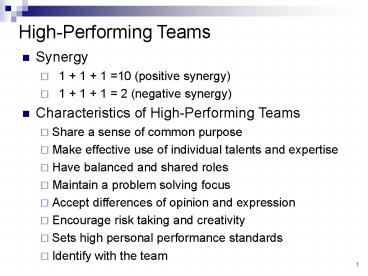High-Performing Teams - PowerPoint PPT Presentation
Title:
High-Performing Teams
Description:
Title: Project Management 3e. - Gray and Larson Subject: Chapter 11 Author: Charlie Cook, University of West Alabama Last modified by: moody_l Created Date – PowerPoint PPT presentation
Number of Views:204
Avg rating:3.0/5.0
Title: High-Performing Teams
1
High-Performing Teams
- Synergy
- 1 1 1 10 (positive synergy)
- 1 1 1 2 (negative synergy)
- Characteristics of High-Performing Teams
- Share a sense of common purpose
- Make effective use of individual talents and
expertise - Have balanced and shared roles
- Maintain a problem solving focus
- Accept differences of opinion and expression
- Encourage risk taking and creativity
- Sets high personal performance standards
- Identify with the team
2
The five-stage team development model
FIGURE 11.1
3
Conditions favorable to the development of high
performance project teams
- Ten or fewer team members
- Voluntary team membership
- Continuous service on the team
- Full-time assignment to the team
- An organization culture of cooperation and trust
- Members report only to the project manager
- All relevant functional areas are represented on
the team - The project has a compelling objective
- Members are in speaking distance of each other
4
The punctuated equilibrium model of group
development
FIGURE 11.2
5
Creating a high-performance project team
FIGURE 11.3
6
Building high-performance project teams
- Recruiting Project Members
- Factors affecting recruiting
- Importance of the project
- Management structure used to complete the project
- How to recruit?
- Ask for volunteers
- Who to recruit?
- Problem-solving ability
- Availability
- Technological expertise
- Credibility
- Political connections
- Ambition, initiative, and energy
7
Project team meetings
Establishing Ground Rules
Managing Subsequent Meetings
Conducting Project Meetings
Planning Decisions
Relationship Decisions
Tracking Decisions
Managing Change Decisions
8
Establishing a team identity
Effective Use of Meetings
Co-location of team members
Creation of project team name
Team rituals
9
Requirements for an effective shared vision
FIGURE 11.4
10
Managing project reward systems
- Group Rewards
- Who gets what as an individual reward?
- How to make the reward have lasting significance?
- How to recognize individual performance?
- Letters of commendation
- Public recognition for outstanding work
- Desirable job assignments
- Increased personal flexibility
11
Orchestrating the decision-making process
12
Managing conflict within the project team
- Encouraging Functional Conflict
- Encourage dissent by asking tough questions.
- Bring in people with different points of view.
- Designate someone to be a devils advocate.
- Ask the team to consider an unthinkable
alternative. - Managing Dysfunctional Conflict
- Mediate the conflict.
- Arbitrate the conflict.
- Control the conflict.
- Accept the conflict.
- Eliminate the conflict.
13
Conflict intensity over theproject life cycle
FIGURE 11.5
14
Rejuvenating the project team
- Informal Techniques
- Institute new rituals.
- Take an off-site break as a team from the
project. - View an inspirational message or movie.
- Have the project sponsor give a pep talk.
- Formal Techniques
- Hold a team building session facilitated by an
outsider to clarify ownership issues affecting
performance. - Engage in an outside activity that provides an
intense common experience to promote social
development of the team.
15
Managing virtual project teams
- Challenges
- Developing trust
- Exchange of social information.
- Set clear roles for each team member.
- Developing effective patterns of communication.
- Include face-to-face if at all possible.
- Keep team members informed on how the overall
project is going. - Dont let team members vanish.
- Establish a code of conduct to avoid delays.
- Establish clear norms and protocols for surfacing
assumptions and conflicts. - Share the pain in terms of multiple time zones.
16
24-hour global clock
FIGURE 11.6
17
Project team pitfalls































